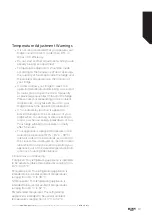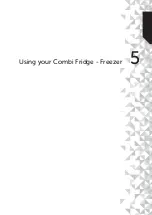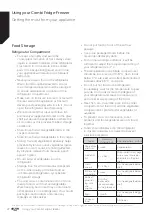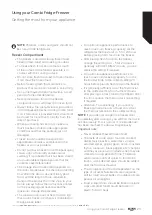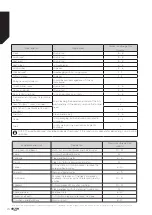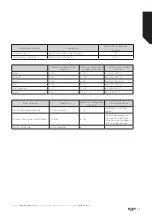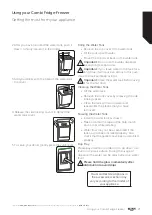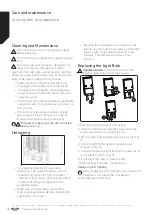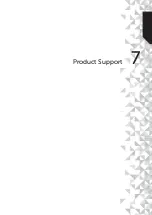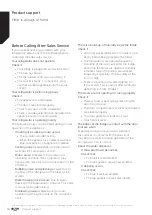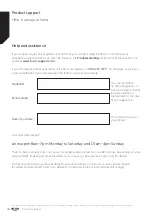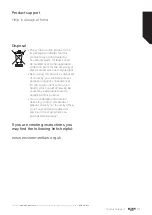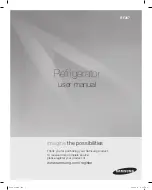
If you require any technical guidance or find that your product is not operating as intended, a simple solution can often be found in the Troubleshooting section of these instructions.
22
Using your Combi Fridge-Freezer
Getting the most from your appliance
Food Storage
Refrigerator Compartment
•
To reduce humidity and avoid the
consequent formation of frost, always store
liquids in sealed containers in the refrigerator.
Frost tends to concentrate in the coldest
parts of the evaporating liquid and, in time,
your appliance will require more frequent
defrosting.
•
Never place warm food in the refrigerator.
Warm food should be allowed to cool at
room temperature and should be arranged
to ensure adequate air circulation in the
refrigerator compartment.
•
Make sure no items are in direct contact with
the rear wall of the appliance as frost will
develop and packaging will stick to it. Do not
open the refrigerator door frequently.
•
We recommend that meat and clean fish
are loosely wrapped and stored on the glass
shelf just above the vegetable bin where the
air is cooler, as this provides the best storage
conditions.
•
Store loose fruit and vegetable items in the
crisper containers.
•
Store loose fruit and vegetables in the crisper.
•
Storing fruit and vegetables separately helps
prevent ethylene-sensitive vegetables (green
leaves, broccoli, carrot, etc.) being affected
by ethylene-releaser fruits (banana, peach,
apricot, fig etc.).
•
Do not put wet vegetables into the
refrigerator.
•
Storage time for all food products depends
on the initial quality of the food and an
uninterrupted refrigeration cycle before
refrigerator storage.
•
To avoid cross-contamination do not store
meat products with fruit and vegetables.
Water leaking from meat may contaminate
other products in the refrigerator. You should
package meat products and clean any
leakages on the shelves.
•
Do not put food in front of the air flow
passage.
•
Consume packaged foods before the
recommended expiry date.
•
For normal working conditions, it will be
sufficient to adjust the temperature setting of
your refrigerator to +4 °C.
•
The temperature of the fridge compartment
should be in the range of 0-8 °C, fresh foods
below 0 °C are iced and rotted, bacterial load
increases above 8 °C, and spoils.
•
Do not put hot food in the refrigerator
immediately, wait for the temperature to pass
outside. Hot foods increase the degree of
your refrigerator and cause food poisoning
and unnecessary spoiling of the food.
•
Meat, fish, etc. should be store in the chiller
compartment of the food, and the vegetable
compartment is preferred for vegetables. (if
available)
•
To prevent cross contamination, meat
products and fruit vegetables are not stored
together.
•
Foods should be placed in the refrigerator
in closed containers or covered to prevent
moisture and odors.
Food
Maximum
storage time
How and where to store
Vegetables
and fruits
1 week
Vegetable bin
Meat and
fish
2 - 3 Days
Wrap in plastic foil, bags,
or in a meat container
and store on the glass
shelf
Fresh
cheese
3 - 4 Days
On the designated door
shelf
Butter and
margarine
1 week
On the designated door
shelf
Bottled
products
e.g. milk
and
yoghurt
Until the
expiry date
recommended
by the producer
On the designated door
shelf
Eggs
1 month
On the designated egg
shelf
Cooked
food
All shelves
•
Using your Combi Fridge-Freezer
Summary of Contents for F54180FFWTDB
Page 1: ...Instruction manual Combi Fridge Freezer F54180FFWTDS F54180FFWTDB F54180FFWTDW ...
Page 5: ...Safety Information 1 ...
Page 9: ...Getting to know your Combi Fridge Freezer 2 ...
Page 13: ...Installing your Combi Fridge Freezer 3 ...
Page 17: ...Functions 4 ...
Page 21: ...Using your Combi Fridge Freezer 5 ...
Page 29: ...Care and Maintenance 6 ...
Page 33: ...Product Support 7 ...
Page 42: ...Contact www bush support com Helpline 0345 257 7271 52282419 ...












